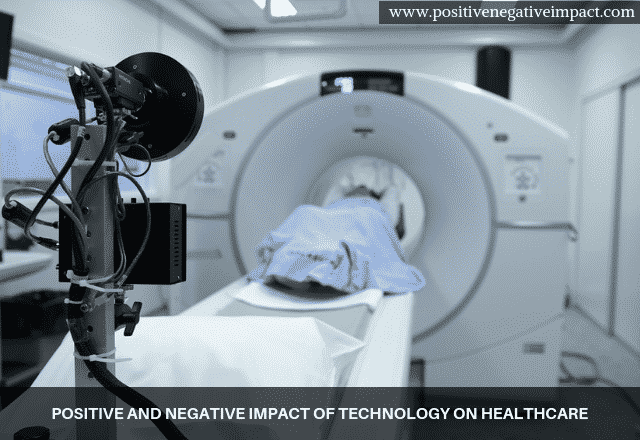Our daily lives have been revolutionized by technology. From the moment we wake up we begin interacting with our phones, computers, and vehicles. One of the most important sectors revolutionized by technology is healthcare. As all great advances, this comes with its own pros and cons.

Positive Impact of Technology in Healthcare
Effectively Monitor Health
Medical technology has positively impacted patients as well as healthcare providers. This has been especially noticeable in the enhanced medical care providers are offering patients.
Precise diagnosis of medical issues is easier. This allows doctors to prescribe the right course of treatment with limited information.
EHR or Electronic Health Records
At one time, all patient records were stored as hard copies. This was a major barrier to access them. Technology has automated the entire process. Doctors, technicians, and nurses can upload the data to digital form allowing for quick and easy access.
Electronic Health Records (EHRs) provide quick access to comprehensive medical history. With this information at their fingertips, diagnosis and treatment has never been easier.
Remote Access
Millions of people don’t live within 30 miles of a hospital. Even for minor health issues, some people spend their entire day traveling to a doctor and back. Telemedicine healthcare solutions has revolutionized this process. Seventy percentage of healthcare providers now offer these solutions. This has allowed millions of people in remote areas to access affordable and convenient healthcare.
Promotes Productivity
Improved health expands beyond direct healthcare. Mobile applications like Smoke Free is an amazing tool to quit smoking. Freeletics provides you with a personal trainer and tailored healthcare plan. Apples Watches and FitBits count your steps and measure your heart rate. There are thousands of apps out there that focus on mental and physical self-improvement.
Improved Work Efficiency
Work efficiency in clinics and hospitals has increased due to use of electronic databases and better equipment. Doctors and nurses now use handheld devices like tablets that are fully optimized to execute medical applications.
These devices provide doctors with an ability to access heart readings, record and supervise medical history, and health status of patients. There are several apps that provide diagnostic lab test tools, drug interaction checkers, medical dictionaries, and treatment guides to patients.
Negative Impact of Technology on Healthcare
Increased costs:
Technology has contributed to medical care becoming more expensive. Even simple consultations and procedures are out of reach for thousands. Because treatment is out of reach, financial and health outcomes are worse for millions of people. Medical bankruptcies are the most common type in the United States, a country without a public option.
Impersonal health care:
The rise of telemedicine has led to an increase in faulty diagnosis. Not being able to see physical symptoms can cause doctors and nurses to miss issues that they would have caught in person.
Impersonal health care also relates results reactive vs. preventative healthcare. Instead of treating the root causes of health issues, medical professionals will only treat health problems as they arise.
Centralized Data Storage
Centralized data storage is useful, but can lead to over dependence. Consequences can be severe if there are electrical or connectivity issues.
If the issues are severe, millions of people’s medical records could be lost forever.
Hacking of Medical Records
Concerns over medical record privacy has increased as data has become more centralized. Millions of people’s medical records have been hacked over the last 10 years. Beyond this, there have been cases of people use fake IDs to buy prescription drugs and medical equipment and fake insurance claims.
- Tulip Mania – The Story of One of History’s Worst Financial Bubbles - May 15, 2022
- The True Story of Rapunzel - February 22, 2022
- The Blue Fugates: A Kentucky Family Born with Blue Skin - August 17, 2021
